Back in January 2015, the Indian liberal ecosystem on social media erupted in loud jeers against Science and Technology minister Dr. Harshvardhan for stating the well established fact that Pythagoras Theorem had been known in India long before Pythagoras.

The vast majority of fake news aims to turn lies into truth. The Left pulled off a veritable coup that day. It managed to spin truth into a lie.
Propagandists always have their eyes on science. Because science occupies such an exalted place in our collective psyche, we must forever be watchful of attempts by political lobbies to seize and control what is put out before the public in the name of science.
It is thus with extreme alarm that one must take note of the so called “March for Science” scheduled for August 9 in various Indian cities; a program that outlines its aims as follows :

As everything with the Indian ‘liberals’ is, this one too is not original. The idea is copied from a “March for Science” that took place, mostly in the US, in April this year and was portrayed by some as an anti-Trump activism. However, let us look at the Indian context and facts about this “march”.
Article 51 A : a diabolical spin on Science
That the aim of this march is political is immediate from the appeal to the spirit of Article 51A, i.e., the Fundamental Duties listed in the Constitution. This article was not part of the original Constitution, but was added by Indira/India Gandhi in the 42nd Amendment of 1976 at the height of the Emergency.
The democratic Constitution was supposed to empower the citizen with Fundamental Rights. These rights were gutted during the Emergency. Instead, Article 51A became the intellectual core of the Emergency, because it shifted the onus to the citizen, who must submit to the almighty state by means of Fundamental Duties.
And for good measure, Article 51A starts out by demanding that the citizen show respect to symbols of the state such as the Flag and the Anthem (wonder how leftists would feel about that today?). And by requiring every citizen to strive for excellence so as to keep raising the nation as a whole to higher levels.
As for the specific line that the “March for Science” folks are referring to, here it is in full:
“…. to develop the scientific temper, humanism and the spirit of inquiry and reform”
And now listen to Leon Trotsky describe the New Soviet Man that the Communists wanted to engineer :
“Man will make it his purpose to master his own feelings, to raise his instincts to the heights of consciousness, to make them transparent, to extend the wires of his will into hidden recesses, and thereby to raise himself to a new plane, to create a higher social biologic type, or, if you please, a superman.”
Suffice to say that science cannot flourish in the spirit of Article 51A, which was intended to emphasize obedience to the state rather than freedom of the individual. That a “March for Science” would make this relic of the Emergency the centerpiece of their thinking suggests that it is little more than a show of yearning for the return of the absolute power of the old Nehru Gandhi establishment.
China celebrates its past, India denigrates
When the Left stood their ground on the lie regarding Pythagoras theorem, it was obviously banking on their years of groundwork in the education system, sowing an inferiority complex deep into the minds of Indians. To the point that they were reasonably confident that the majority of educated Indians would reflexively reject any possibility of their own ancestors having produced anything of slightest value.
The Chinese on the other hand, have learned from the disaster of Mao’s “Great Leap Forward” 1958-1962, when the Communist Party tried to “modernize” the nation by cutting it off from its ancient roots. Among other things, it led to the death of an estimated 200-500 lakh people (no typo there!) Today, the Chinese take great pride in their ancient culture and achievements.
In 2015, Chinese scientist Tu Youyou received the Nobel Prize in medicine for her treatment of malaria that has saved millions of lives across the world. The key chemical involved was Artemisinin, which was discovered when Tu Youyou and her colleagues delved into medicinal herbs used by the Chinese for thousands of years.
Who’s to say that there aren’t similar gems hiding in the treasure trove of ancient India? We’ll probably never know because ancient Indian science has been stigmatized by liberal discourse to the point that our best minds will automatically be discouraged from investigating it.
And for the record, the Chinese knew about Pythagoras theorem as well much before Pythagoras. The Chinese boldly proclaim this to the world, as seen in this logo on the website of the Chinese Academy of Sciences.

I suppose there is no Huffington Post in China to turn their history into lies. Anyway…
Infusing science with anti-semitism
Looking at the “Appeal by Scientists” here on the website of the Breakthrough Science Society that is organizing the march, a telltale fact that emerges is that one of the “scientists” making the appeal is JNU professor Ayesha Kidwai. It is a disturbing fact that Ms. Kidwai is involved with the “Indian Campaign for Academic and Cultural Boycott of Israel”.
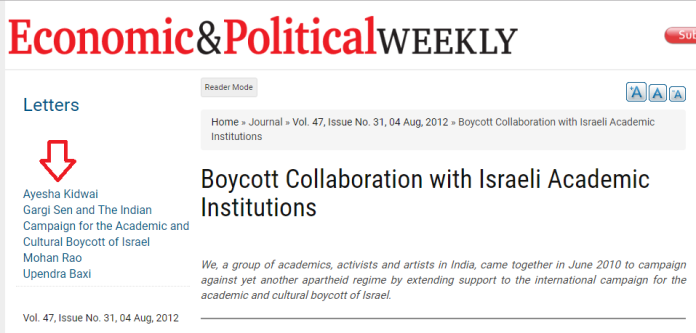
Those who want to slice up and divide knowledge (including scientific knowledge) based on the race, gender or nationality of who finds that knowledge cannot be seen as anything but enemies of science.
Does a scientific fact become less true if an Israeli person were to discover it? Should such a truth be boycotted? Is it not a foolish endeavor to try to boycott truth? How is this compatible with the spirit of scientific inquiry?
What kind of “scientist” would refuse to engage with a scientific idea because it came from someone in Israel?
Additionally, it must be noted that Ms. Ayesha Kidwai is not even a scientist (see official JNU profile here), but is still included in the list of “scientists” making the appeal. The only possibility that remains is that Ms. Kidwai has been included for purely political reasons, making the motives of the “March for Science” absolutely clear.
It should also be noted that passing off non-scientists in the disguise of scientists is standard operating procedure of pseudo-scientific and anti-scientific initiatives.
Selective outrage
In keeping with the Left’s agenda of colonizing science, there has been a concerted effort to give widely publicity to superstitious / unscientific views expressed by members of the ruling BJP and its wider ideological parivar. As seen in the case of Pythagoras’ Theorem, the eagerness to drive this agenda has often overshadowed basic fact checking.
However, the left generally stays silent when it comes to supporting real science on the ground … such as the time they could have come out and supported the BJP government in Maharashtra in requiring Madrasas to teach Math & Science. But they didn’t. Because votes. Minor children missing out on a chance to learn science be damned.
The left wing’s love for science appears to exist only at the media propaganda level. For instance, Prime Minister Modi’s remarks on Ganesha and plastic surgery have been magnified into some kind of legendary anti-science statement. Leaving aside the established fact that plastic surgery may well have existed in ancient India (as grudgingly conceded later by some liberals), the fact is that political parties and politicians engaging with unscientific thinking is not new.
In early 2013, Shashi Tharoor had launched the “Tiranga bangle” along with fellow Congress MP Navin Jindal.
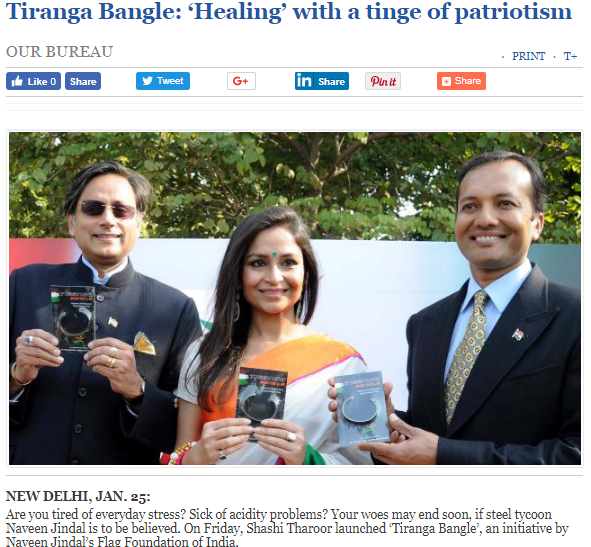
The “Tiranga bangle” claimed to work wonders for treating everything from arthritis to gout to carpal tunnel syndrome. In keeping with the noblest traditions of pseudo-science, little was disclosed about the scientific mechanism behind the “miracle bangle”, except informing us that it had been designed with “tri-vortex technology from South Africa”. At that time, Shashi Tharoor was even MoS for Human Resource Development, but his participation in propagating pseudo-science did not become an issue.
One could go on and give several other examples, but the grand daddy of unscientific remarks by top Indian politicians would be Pandit Nehru saying that the whole world sleeps at the stroke of the midnight hour in India instead of realizing that many parts of the world experience broad daylight when it is night over here! Again, Pandit Nehru’s famous words are often read with pride, with no admission of the astonishing scientific error contained therein. And yeah, don’t tell me I am indulging in literalism here, because I’m just adopting ‘liberal techniques’.
When it comes to the Left parties, the situation is even more grim. Based on their reading of Marx, the Communists have long opposed the Big Bang theory, which is the prevailing, well accepted cosmological model for the universe. Here is the official website of the CPI(M):
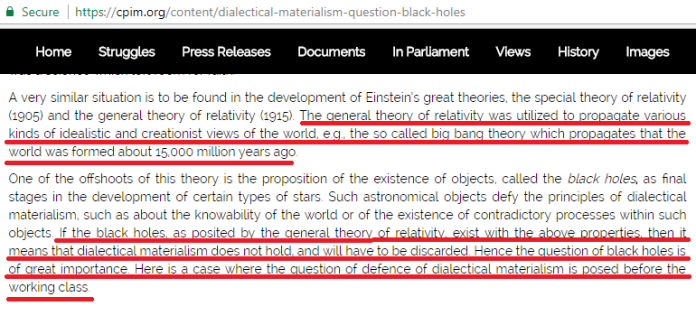
The “so called Big Bang Theory” an “idealistic and creationist view of the world”? Calling on the “working class” to defend Marxist thinking by proving that black holes do not exist?
This sounds like an extract from the Mad Hatter talking in Alice in Wonderland, but unfortunately this stuff is coming from the website of the CPI(M). Ironically, the same CPI(M) often claims to take the lead in protecting “scientific temper” and the so-called Science Rakshaks in the media and intelligentsia generally have little to say about the Communist war on science.
Now, I don’t know if Marx ever said that the Big Bang theory is wrong. Even if he did, it wouldn’t matter because he was not a physicist. But like any religious fundamentalist, the Communist takes a Boko Haram like approach to science, rejecting outright any idea that in his imagination appears to contradict something in his holy book. And calls upon the working class (i.e., the faithful) to defend their faith.
For those interested (and amused) by the silliness of asking the working class to fight black holes, the abstract of this paper [pdf] written by a historian of science at Aarhus University in Denmark describes lucidly why Communists went nuts opposing the big bang theory.
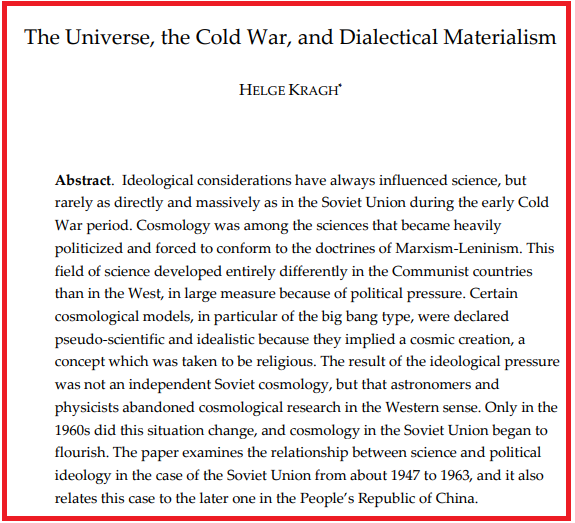
Maligning the scientific method and individual scientists
Being the current Vice Chancellor of JNU, Prof. M Jagadesh Kumar (who is also a professor of Electrical Engineering at IIT Delhi) is one of the prime targets for the liberal left. This hilarious hit-job which appeared in the DailyO, makes a desperate effort to malign his character.
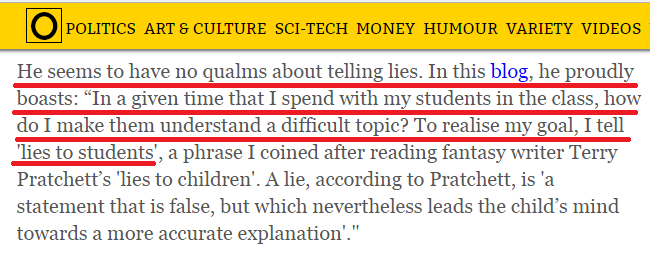
What? Prof. M Jagadesh Kumar boasts on his blog about lying to his students? What is the author talking about? I guess we are supposed to take the accuser seriously because it happens to be some Ashok Swain, a professor of Peace and Conflict Studies at Uppsala University in Sweden (for the record, he is someone who was earlier found pushing a narrative that coincidentally aligns with Pakistan’s anti-India policy, but let us forget that as of now).
However, clicking on the link to Prof. M Jagadesh Kumar’s blog reveals this hitjob to be an example of shocking scientific illiteracy on the part of the ‘liberal’ author who tried to malign him. Prof. Jagadesh Kumar was talking in the context of physical equations which often contain an approximation along with an error term. The word “lies” was just a cute term he was using to describe approximations and to emphasize their importance in science. Anyone who has taken high school calculus should be able to understand this concept.
However, in the world of left liberals, maligning individual scientists as well as scientific method is not an ethical concern when it comes to advancing a political agenda. Oh, and do you now get it when I said earlier in this article that literalism was a liberal technique?
In earlier cases, we have seen that even the most eminent scientists haven’t been spared the sword of the liberal agenda. For instance, a 2002 article by Sagarika Ghose written at the time Dr. Kalam was nominated for President, claims to have discovered a connection between atomic scientists, Hindu chauvinism, sexism and even casteism. Other gems include the finding that “science is particularly compatible with religious fundamentalism” (you read that right!) and that Osama bin Laden becoming a terrorist may have something to do with his engineering background in college.
Is calculus a rape manual?
Since both science and liberalism are global in their outlook, it forces us to take a wider view to understand how the left has tried to impose its worldview of science.
Extreme examples include left-wing animal rights groups going to the extent of bombing homes of scientists who are accused of cruelty to anything from lab mice to insects. Often, these are scientists carrying out vital researches into boosting agricultural productivity or developing life saving medicines. This University of California scientist got his house firebombed for being cruel … to fruitflies!
On the other hand, the environmental lobby, a pet darling of the international left, has often provided a safe home to all kinds of anti-scientific thinking. Mixing science with politics, the 9/11 attacks were another situation when major elements of the left aggressively pushed for science denial. By the way, here is a video of ‘youth icon’ Kanhaiyya Kumar pushing for 9/11 conspiracy theories on the basis of fake science documentaries he watched on YouTube :
9/11 was inside job- Kanhaiya Kumar
Muslims are eternal victims pic.twitter.com/DKcHbHjNUi
— ? (@donaldtrump88) July 9, 2017
This may be a bitter pill for leftists to swallow, but scientific truth once established leaves no scope for “dissent”, least of all for “counterarguments” based on politics. No Azaadi from truth. Sorry.
However, one of the most outrageous yet least reported forms of anti-science propaganda comes from within the feminist movement. Is it possible for the human mind to become so muddled by ideology that high school mathematics looks like it is related to rape? Please hear out top feminist thinker Sandra Harding explain how calculus can be seen as a “rape manual”.
For this and other brilliant insights, Ms. Sandra Harding received a coveted position at UCLA! Can you imagine how the left-wing intelligentsia would have reacted if someone associated with RSS had drawn a connection between mathematics and rape and was then legitimized with a professorship at a major Indian university?
Within the belly of feminism, there are several other such anti-scientific gems. For instance, did you know that Einstein’s E=mc^2 is a “sexed equation” (click here to find out why)?
Conclusion
We have to understand the basic modus operandi of liberalism. It identifies a group of people and hijacks their narrative, claiming to speak for all of them. The target group is then put within the left ideological cage and any attempt to break free is met with harshest kind of intimidation.
How did the women’s movement worldwide or Dalit politics in India get straitjacketed into a socialist, quasi-communist movement? Was Ambedkar a Communist? He vehemently was not! How come “Ambedkarite” today most commonly means someone with Communist leanings? Because liberalism imprisoned these movements in its ideological cage.
Science is not and cannot become a political party. Science cannot live in a cage. A left-wing ideological “March for Science” denigrates science and the scientific method.
Finally, to non-scientist Ms. Ayesha Kidwai who is part of the “appeal by scientists” for this “March for Science”, I have this to say: You can boycott a scientific truth and/or bully others into boycotting a scientific truth because it may have been found by someone from Israel or wherever, but you won’t win. Because :
E pur si muove (And yet it moves)
It’s attributed to Galileo when he was coerced by the Church to officially take back his view that the Earth moves around the sun.















